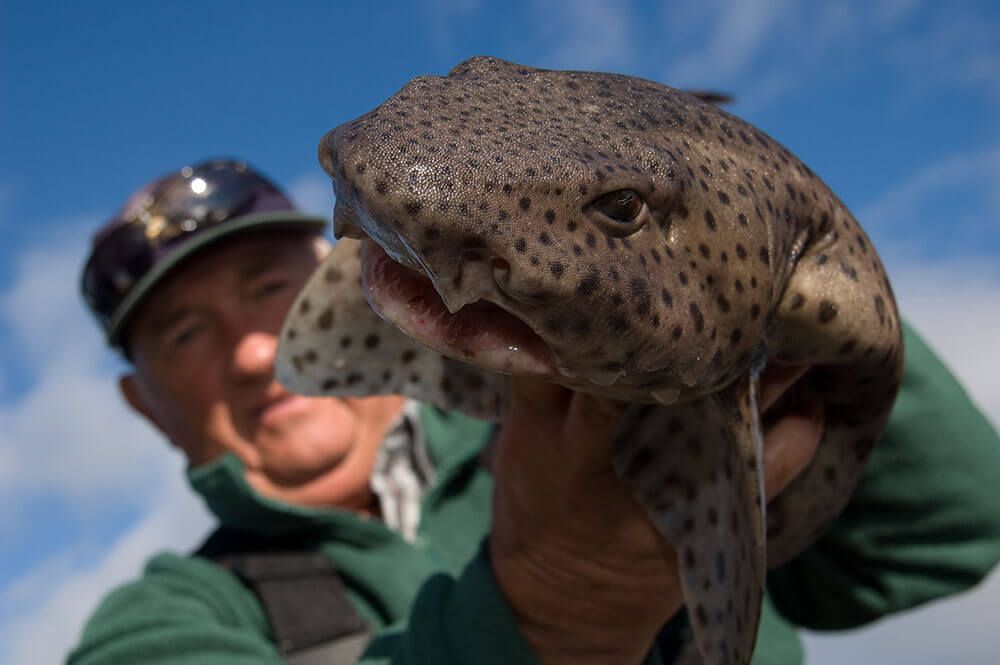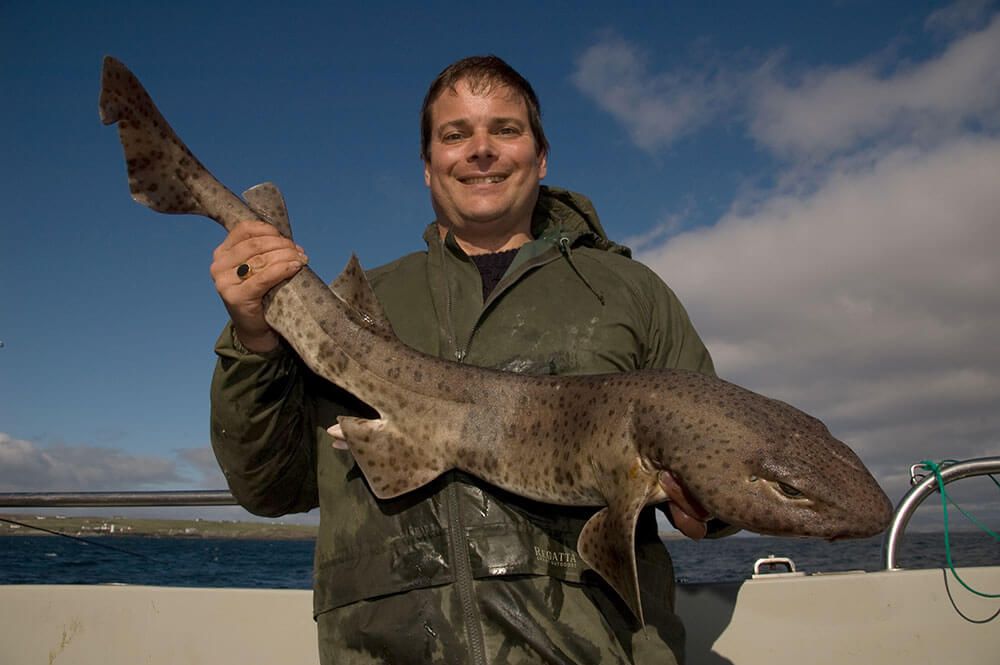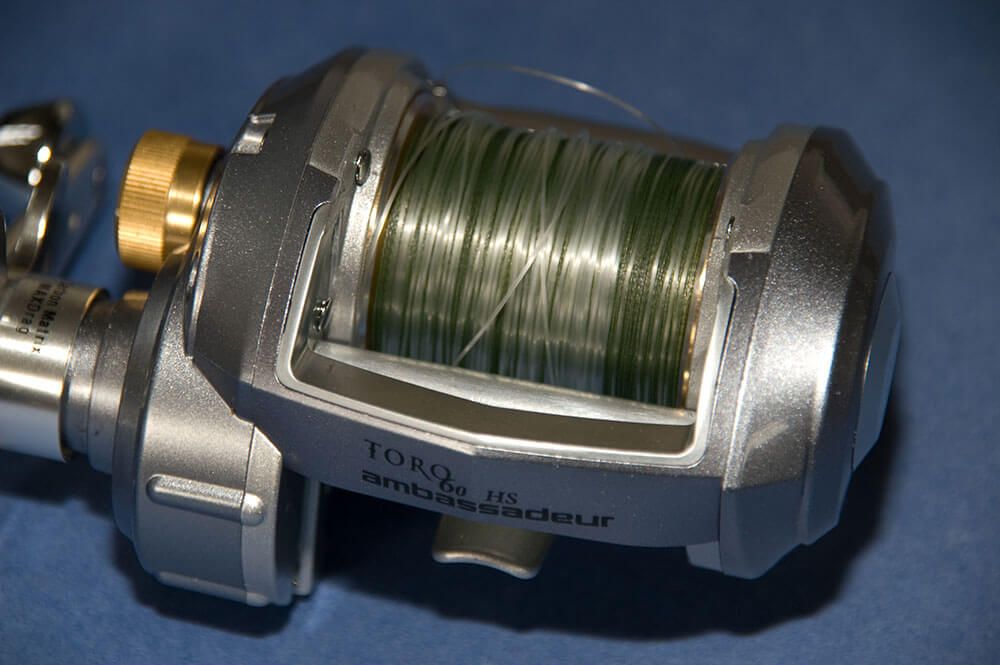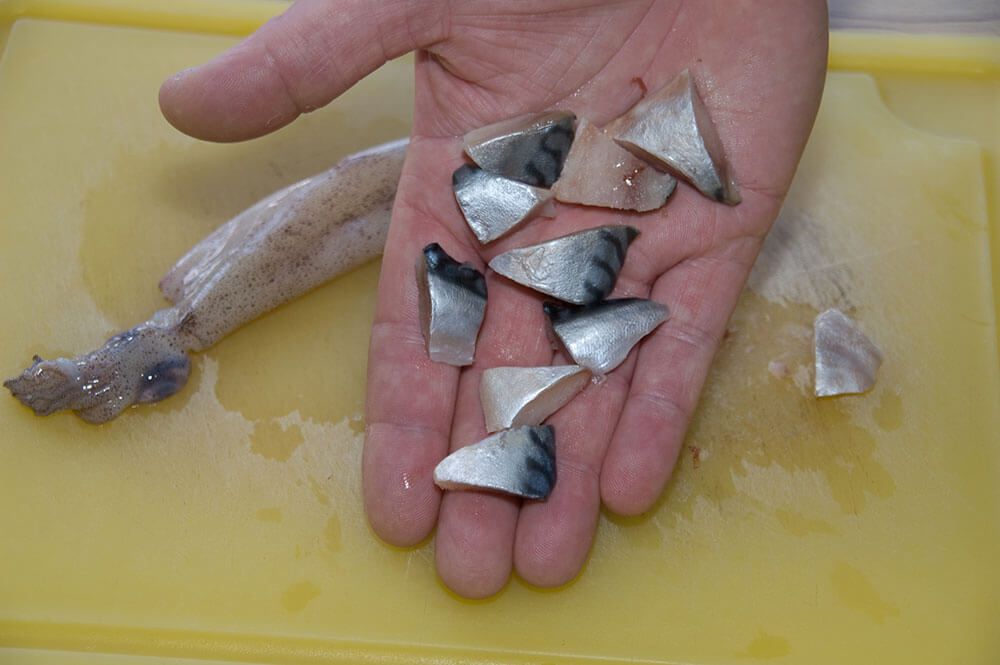Huss are a member of the Scyliorhinidae shark family compromised of around 60 mainly shallow water species. In the UK Bull Huss are also known by generalised names including Nursehound and Greater Spotted Dogfish.
Smaller huss are often confused with the lesser spotted dogfish, but telling the two apart is easy. Look at the lower side of the top jaw of the huss and you’ll see that the nasal flaps are individual covering each nostril, but they do not reach the edge of the mouth. On the dogfish the nasal flap joins to the edge of the mouth. Also look at the first dorsal fin, which on the huss is positioned vertically above the base of the pelvic fin, but on the dogfish is positioned further back and is not in line.

The colouring depends on the ground the huss is commonly feeding over. On sand the colouration will be fawn with speckled darker blotches on the back and flanks. Rock dwelling huss can be dark brown, jet black or slate grey with a distinct white belly also carrying darker blotches. The eye is large to pull in maximum light at depth.
Huss are formed with a flat belly and lower jaw with a large head and slender body denoting a bottom feeder adept at hunting through narrow rock gullies and boulders, also scavenging over clean seabed’s literally cleaning up after major predator attacks from fish such as tope.
Look at the teeth and you’ll see a mini shark. The jaws carry six visible rows of teeth. As the huss loses a tooth, a replacement is drawn forwards to replace it. The teeth are dagger shaped, slightly curved backwards and needle sharp. The huss is not just a scavenger then, but a top predator capable of rapid bursts of speed to catch prey and an excellent exponent of the ambush when working rocky ground.
It eats most anything, but typically takes crabs and squat lobsters, hermit crabs, scallops and razorfish, also small flatfish, whiting, poor cod, pout and anything left over by bigger predators that drops through to the seabed. Huss rarely go hungry.
Female huss lay eggs enclosed in smooth, oblong shaped rounded cases around 4-inches long which they wrap around the stalks of kelp and rocks by tendrils attached to the corners of the cases. The juvenile huss take 9 months to develop and will measure about 6 inches long when hatching from the purse.
WHEN AND WHERE TO FISH
Huss can be found right around the UK, but are far more common in the west of the country, particularly off the Devon and Cornish coast, inside the Bristol Channel, they are very prolific off the west coast of Wales, also the west coast of Scotland and off the southern and western Irish coast. They are also found as far north as southern Norway and south throughout the Mediterranean to North Africa.

Huss are available in most of the quoted UK areas throughout the full 12-month period, however their main season is from mid April right through to early January. The autumnal period from September to early December provides the best catches along the west coast of the UK and in Ireland.
It’s no surprise that the adaptive huss can be found over very varied ground. Their typical habitat is amongst reef and rough ground in depths down to 100-feet, but they can also be found in depths down to 200-feet. They will also roam over clean sand in close proximity to rougher ground, and are often resident around shallower wrecks close to shore.
BOAT HUSS TACKLE
The choice of tackle depends on the depth and tide speed. In most areas a standard 20lb class rod matched to a reel capable of carrying either 300-yards of 20lb mono or alternatively a top shot of 300-yds of braid is ideal. Mono is okay for general fishing, but choose the braid in deeper water and fast running tides.
In the Bristol Channel anglers prefer to use uptide rods casting well away from the boat, but again in deeper water, go for braided lines to limit tide resistance.

In areas where huss are often caught in water less than 40-feet deep, such as Cardigan Bay in Wales, anglers prefer a light 12lb class rod, a reel such as an ABU Revo Toro 60 or 7000 sized reel carrying 15lb mono or 20lb braid. Add a short, double the length of the rod, shock leader to give some stretch when using braid.
HOW TO MAKE A BOAT HUSS RIG
HOW TO MAKE A BOAT HUSS SQUID BAIT
TOP TIP 1
Try to locate areas where dominant ground feature can break the full flow of the tide and fish the downtide side. Huss prefer to work inside the calmer water on the edge of the passing tide. Also fish the outer edges just inside the main tide run of smaller bays and coves and inside smaller rocky headlands.
TOP TIP 2
When resident around wrecks huss tend to feed best during the hours either side of low and high water and prefer to be on the downtide side of the wreck. This also indicates that in areas where the tide run is fast, the best tides to fish will be the smaller neap tides when the huss can feed easier.
TOP TIP 3
When fishing off the stern of the boat, huss will be drawn in by the smell of the other baits but especially by the vibrations given off by smaller fish such as whiting, dabs, pouting, rockling etc. It is always an advantage to have a couple of anglers deliberately fishing smaller baits designed to catch the smaller fish to build up a feeding zone to draw the huss in.
TOP TIP 4
Chopping up small bits of mackerel or herring and flicking a few periodically over the side in shallow to medium depth water is also a good way to pull huss in from further downtide. Being a member of the shark family they can detect scent in small quantities from a long distance away.

TOP TIP 5
Huss often gently “tap” several times on the rod tip before fully pulling the rod tip over. Don’t strike until the weight of the fish is pulling hard on the rod tip indicating the fish has fully taken the bait and is moving away.
TOP TIP 6
Keep your hooks ultra sharp and strike only when you feel the full weight of the fish on the line. Huss have very bony mouths and often the fish will be brought to the surface just holding on to the bait without the hook getting a penetrative hold. As they near the surface they will just spit the bait out.
TOP TIP 7
Huss are also attracted to noise. It will often improve catches if you add a rattling Booby Bead about 12-inches up above the hook on the trace. A good way is to use a double Booby Bead trapped between rubber rig stops or stop knots. This then spins on the line in the tide and maximises the rattling effect.
TOP TIP 8
Holding huss for the camera is difficult as they are super strong fish able to contort their long bodies. A good tip is to gently hold the tail, then put the other hand under the body just rear of the head. This gentle way of holding them tends to relax them. If you hold them too hard they will just keep trying to twist and free themselves.
TOP TIP 9
Frozen sandeel is very effective for huss. You need two medium to large launce sandeels and cut the head off one and the tails off both. Cut the backbone out of the sandeel with the head on but leaving the fillets attached. Slide the hook through the mouth and out between the fillets and slide the eel up the hook trace. The second eel is pushes around the hook tail end first leaving the hook point clear. Pull the filleted sandeel down over the lower one and bind the two together with bait elastic. Huss are greedy fish and one hook is enough.
TOP TIP 10
Freshly caught food fish like poor cod and pout, either whole smaller fish or fillets from them, are often the very best baits and its well worth fishing a second rod using small hooks to catch a few “natural” baits to maximise your chances. Bluey is also proving to be a top huss bait due to its massive oil content.
Smaller huss are often confused with the lesser spotted dogfish, but telling the two apart is easy. Look at the lower side of the top jaw of the huss and you’ll see that the nasal flaps are individual covering each nostril, but they do not reach the edge of the mouth. On the dogfish the nasal flap joins to the edge of the mouth. Also look at the first dorsal fin, which on the huss is positioned vertically above the base of the pelvic fin, but on the dogfish is positioned further back and is not in line.

The colouring depends on the ground the huss is commonly feeding over. On sand the colouration will be fawn with speckled darker blotches on the back and flanks. Rock dwelling huss can be dark brown, jet black or slate grey with a distinct white belly also carrying darker blotches. The eye is large to pull in maximum light at depth.
Huss are formed with a flat belly and lower jaw with a large head and slender body denoting a bottom feeder adept at hunting through narrow rock gullies and boulders, also scavenging over clean seabed’s literally cleaning up after major predator attacks from fish such as tope.
Look at the teeth and you’ll see a mini shark. The jaws carry six visible rows of teeth. As the huss loses a tooth, a replacement is drawn forwards to replace it. The teeth are dagger shaped, slightly curved backwards and needle sharp. The huss is not just a scavenger then, but a top predator capable of rapid bursts of speed to catch prey and an excellent exponent of the ambush when working rocky ground.
It eats most anything, but typically takes crabs and squat lobsters, hermit crabs, scallops and razorfish, also small flatfish, whiting, poor cod, pout and anything left over by bigger predators that drops through to the seabed. Huss rarely go hungry.
Female huss lay eggs enclosed in smooth, oblong shaped rounded cases around 4-inches long which they wrap around the stalks of kelp and rocks by tendrils attached to the corners of the cases. The juvenile huss take 9 months to develop and will measure about 6 inches long when hatching from the purse.
WHEN AND WHERE TO FISH
Huss can be found right around the UK, but are far more common in the west of the country, particularly off the Devon and Cornish coast, inside the Bristol Channel, they are very prolific off the west coast of Wales, also the west coast of Scotland and off the southern and western Irish coast. They are also found as far north as southern Norway and south throughout the Mediterranean to North Africa.

Huss are available in most of the quoted UK areas throughout the full 12-month period, however their main season is from mid April right through to early January. The autumnal period from September to early December provides the best catches along the west coast of the UK and in Ireland.
It’s no surprise that the adaptive huss can be found over very varied ground. Their typical habitat is amongst reef and rough ground in depths down to 100-feet, but they can also be found in depths down to 200-feet. They will also roam over clean sand in close proximity to rougher ground, and are often resident around shallower wrecks close to shore.
BOAT HUSS TACKLE
The choice of tackle depends on the depth and tide speed. In most areas a standard 20lb class rod matched to a reel capable of carrying either 300-yards of 20lb mono or alternatively a top shot of 300-yds of braid is ideal. Mono is okay for general fishing, but choose the braid in deeper water and fast running tides.
In the Bristol Channel anglers prefer to use uptide rods casting well away from the boat, but again in deeper water, go for braided lines to limit tide resistance.

In areas where huss are often caught in water less than 40-feet deep, such as Cardigan Bay in Wales, anglers prefer a light 12lb class rod, a reel such as an ABU Revo Toro 60 or 7000 sized reel carrying 15lb mono or 20lb braid. Add a short, double the length of the rod, shock leader to give some stretch when using braid.
HOW TO MAKE A BOAT HUSS RIG
HOW TO MAKE A BOAT HUSS SQUID BAIT
TOP TIP 1
Try to locate areas where dominant ground feature can break the full flow of the tide and fish the downtide side. Huss prefer to work inside the calmer water on the edge of the passing tide. Also fish the outer edges just inside the main tide run of smaller bays and coves and inside smaller rocky headlands.
TOP TIP 2
When resident around wrecks huss tend to feed best during the hours either side of low and high water and prefer to be on the downtide side of the wreck. This also indicates that in areas where the tide run is fast, the best tides to fish will be the smaller neap tides when the huss can feed easier.
TOP TIP 3
When fishing off the stern of the boat, huss will be drawn in by the smell of the other baits but especially by the vibrations given off by smaller fish such as whiting, dabs, pouting, rockling etc. It is always an advantage to have a couple of anglers deliberately fishing smaller baits designed to catch the smaller fish to build up a feeding zone to draw the huss in.
TOP TIP 4
Chopping up small bits of mackerel or herring and flicking a few periodically over the side in shallow to medium depth water is also a good way to pull huss in from further downtide. Being a member of the shark family they can detect scent in small quantities from a long distance away.

TOP TIP 5
Huss often gently “tap” several times on the rod tip before fully pulling the rod tip over. Don’t strike until the weight of the fish is pulling hard on the rod tip indicating the fish has fully taken the bait and is moving away.
TOP TIP 6
Keep your hooks ultra sharp and strike only when you feel the full weight of the fish on the line. Huss have very bony mouths and often the fish will be brought to the surface just holding on to the bait without the hook getting a penetrative hold. As they near the surface they will just spit the bait out.
TOP TIP 7
Huss are also attracted to noise. It will often improve catches if you add a rattling Booby Bead about 12-inches up above the hook on the trace. A good way is to use a double Booby Bead trapped between rubber rig stops or stop knots. This then spins on the line in the tide and maximises the rattling effect.
TOP TIP 8
Holding huss for the camera is difficult as they are super strong fish able to contort their long bodies. A good tip is to gently hold the tail, then put the other hand under the body just rear of the head. This gentle way of holding them tends to relax them. If you hold them too hard they will just keep trying to twist and free themselves.
TOP TIP 9
Frozen sandeel is very effective for huss. You need two medium to large launce sandeels and cut the head off one and the tails off both. Cut the backbone out of the sandeel with the head on but leaving the fillets attached. Slide the hook through the mouth and out between the fillets and slide the eel up the hook trace. The second eel is pushes around the hook tail end first leaving the hook point clear. Pull the filleted sandeel down over the lower one and bind the two together with bait elastic. Huss are greedy fish and one hook is enough.
TOP TIP 10
Freshly caught food fish like poor cod and pout, either whole smaller fish or fillets from them, are often the very best baits and its well worth fishing a second rod using small hooks to catch a few “natural” baits to maximise your chances. Bluey is also proving to be a top huss bait due to its massive oil content.

